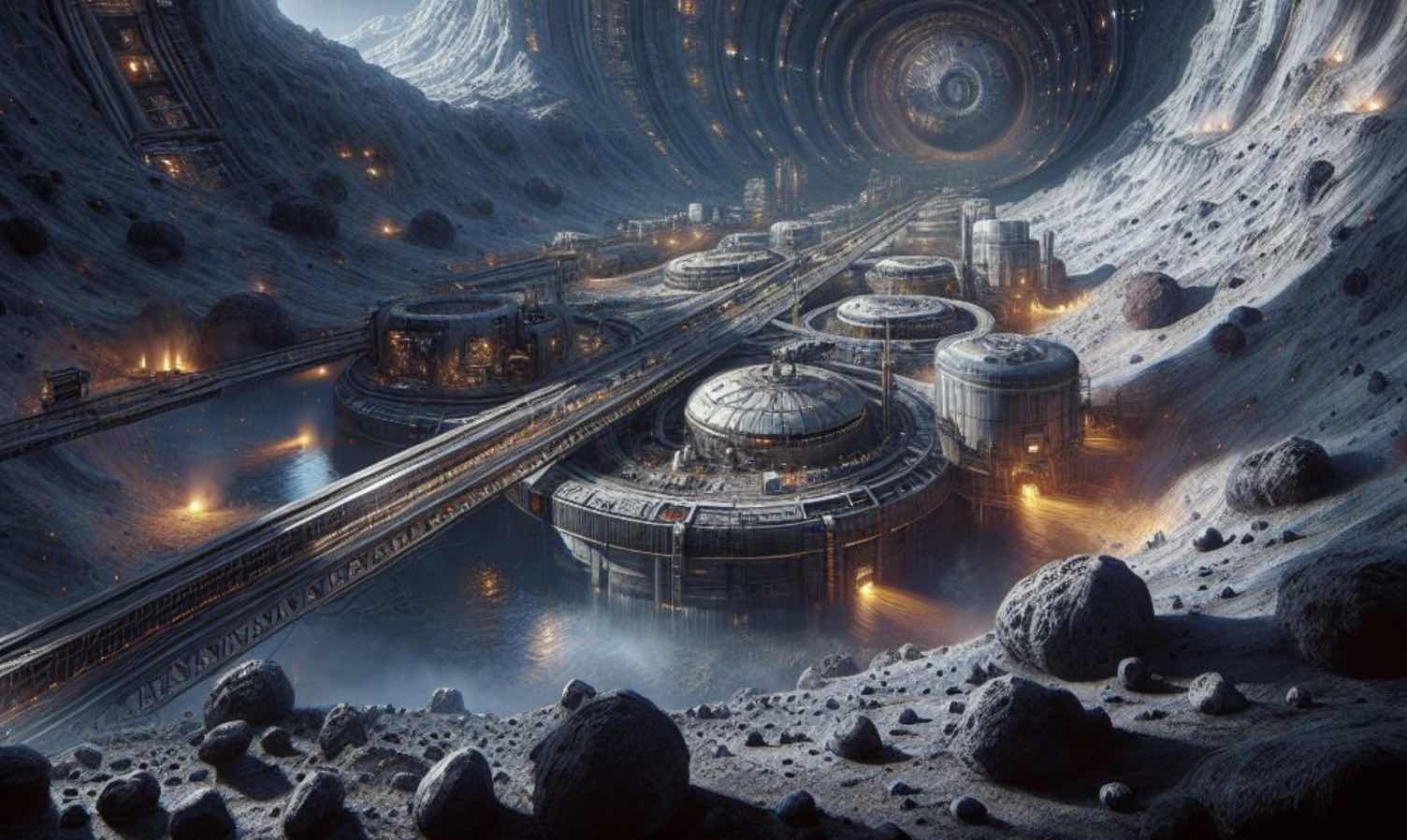The Defense Advanced Research Projects Agency (DARPA) continues to set its sights on the Moon, recently selecting defense giant Northrop Grumman to advance concepts on building a lunar railroad network.
The project is the latest initiative from DARPA’s expansive 10-year Lunar Architecture (LunA-10) Capability Study, which is part of an ongoing effort by the U.S. to establish a permanent human presence on the Moon and a “thriving lunar economy.”
Constructing a lunar railroad system may seem like something from a science fiction movie. Yet, the project reflects the Department of Defense’s (DoD) mysterious focus on lunar operations and potential ambition to establish a strategic military presence on the Moon.
“The envisioned lunar railroad network could transport humans, supplies, and resources for commercial ventures across the lunar surface – contributing to a space economy for the United States and international partners,” Northrop Grumman said in a statement.
According to Northrop Grumman, the company will begin by exploring concepts for constructing and operating a lunar railroad network, including identifying the foreseeable costs, necessary resources, and technological risks associated with such an ambitious endeavor.
The company will also provide DARPA with lunar railroad network prototypes, as well as demonstrations and analyses of how a fully operating system would perform.
DARPA’s plans to develop a lunar railroad network is a strategic initiative reminiscent of the pivotal role railroads played in expanding and developing the United States.
Just as the First Transcontinental Railroad revolutionized the settlement and economy of the American West, this lunar project aims to tackle the unique logistical and operational challenges of establishing a sustainable human and commercial presence on the Moon.
Chris Adams, vice president and general manager at Northrop Grumman’s Strategic Space Systems, emphasized the significance of this initiative. “This investment in key developmental research propels our technology to the forefront of next-generation solutions, establishing a sustainable space ecosystem,” Adams stated.
America’s development of a nationwide railroad network in the 1800s is primarily recognized as a symbol of modernity and national progress. However, the expansion of the First Transcontinental Railroad also came at a significant cost to the landscape and Indigenous communities of the American Midwest.
Many historians argue that the construction of the Pacific Railroad from 1863 to 1869 played a significant role in the near-extinction of the American bison. This was largely due to the railroad’s influx of settlers who hunted the bison extensively.
Furthermore, the arrival of these new settlers, coupled with diminishing natural resources, led to increased tensions and conflicts between the U.S. government and the Indigenous tribes of the region, as the expanded homesteading facilitated by the railroad encroached on their lands.
As a consequence of these developments, Indigenous peoples in the United States ended up losing nearly 99% of the land they had occupied for tens of thousands of years.
The Moon lacks human inhabitants or an ecosystem that a lunar railroad system could potentially disrupt. Nonetheless, this does not eliminate the possibility of unintended consequences as humanity plans to colonize the lunar surface.
As it relates to potential “unintended consequences,” perhaps one of the most pressing questions is why DARPA, the U.S. Department of Defense’s (DoD) primary brain trust, has taken such a keen interest in the Moon in recent years.
In addition to its 10-year Lunar Architecture (LunA-10) Capability Study, several other DARPA programs are developing various technologies to establish and facilitate a permanent human presence on the Moon.
One such initiative, the Demonstration Rocket for Agile Cislunar Operations program, or “DRACO,” looks to identify “leap-ahead” propulsion technologies to allow larger payload transfers between the Earth and the Moon.
Traditionally, NASA, the independent federal agency dedicated to the scientific exploration of aeronautics and outer space, has led America’s space exploration ventures. Yet, DARPA’s recent initiatives to develop lunar infrastructure, such as constructing a moon-based railroad, mark a significant change in how the U.S. is approaching space exploration.
In line with NASA’s emphasis on scientific research, DARPA’s official documents also convey the agency’s goals to foster a “thriving lunar economy” and establish a “civil lunar framework for peaceful U.S. and international use.”
During the announcement of industry partners for DARPA’s 10-Year Lunar Architecture (LunA-10) Capability Study, known as “LunA-10,” Dr. Michael “Orbit” Nayak, a program manager in DARPA’s Strategic Technology Office, underscored the agency’s intention to turn the Moon into an economic extension of the U.S.
“LunA-10 has the potential to upend how the civil space community thinks about spurring widespread commercial activity on and around the Moon within the next 10 years,” Dr. Nayak said. “LunA-10 performers include companies both big and small, domestic and international, each of which brought a clear vision and technically rigorous plan for advancing quickly towards our goal: a self-sustaining, monetizable, commercially owned-and-operated lunar infrastructure.”
Policy experts note that DARPA’s lunar initiatives, such as constructing a lunar railroad network, comply with the United Nations Outer Space Treaty of 1967. This treaty prohibits the militarization of space and requires the Moon and other celestial bodies to be used only for peaceful purposes.
However, there remains a risk of “unintended consequences” similar to those experienced during the construction of the First Transcontinental Railroad. In this case, the conflict would not involve Indigenous populations but could arise from commercialization and competition for lunar resources with another global power: China.
China likewise has plans for a permanent lunar settlement, including a nearly 14-square-mile lunar base with underground facilities, a command and communication center, a power station, laboratories, and a fleet of autonomous robots to support scientific research and commercialization of the Moon.
Even before either country has started constructing permanent settlements on the Moon, NASA Administrator Bill Nelson has accused China of intending to claim resource-rich areas of the Moon as its own sovereign territory, an allegation that Beijing has denied, labeling it a “lie.”
Nevertheless, as recently reported by The Debrief, Beijing plans to extend its advanced mass surveillance network, known as “Skynet,” to the Moon. Expanding its extensive spy network to include the lunar surface suggests China is already preparing for potential disputes with lunar neighbors, particularly the U.S.
The recent lunar railroad initiative by DARPA is not just about creating a novel means of transport but also envisioning a future where the Moon plays a pivotal role in supporting human life and commercial activities.
DARPA’s burgeoning interest in lunar infrastructure development subtly aligns with the DoD’s broader vision to leverage the Moon’s strategic position beyond mere scientific exploration to achieve economic and defense objectives.
It remains to be seen whether perceiving the Moon as a critical asset for U.S. national security and economic development will ultimately lead to earthly conflicts in the future.
In an interview, last year with Space.com, Paul Szymanski of the Space Strategies Center and co-author of The Battle Beyond: Fighting and Winning the Coming War in Space described the sudden international interest in the Moon as “strange.”
“For my entire 50-year career, no one I knew was particularly interested in it [the moon], but now there is extreme attention,” Szymanski said. “In the 1970’s NASA asked the Air Force if they wanted a base on the moon, and they said ‘no,'”
“Yet now, I personally know of companies planning on providing cell phone service on the Moon, and the Air Force Research Lab is developing several programs, such as space surveillance for the far side of the Moon. None of this makes sense unless there is some other not publicly known factor that has changed everyone’s attitudes.”
This article was updated to further clarify the continuities between NASA and DARPA’s scientific and economic objectives for future lunar missions.
Tim McMillan is a retired law enforcement executive, investigative reporter and co-founder of The Debrief. His writing typically focuses on defense, national security, the Intelligence Community and topics related to psychology. You can follow Tim on Twitter: @LtTimMcMillan. Tim can be reached by email: tim@thedebrief.org or through encrypted email: LtTimMcMillan@protonmail.com

